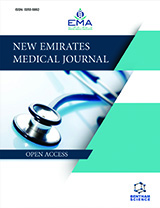Abstract
Introduction: Aphasia, also known as language impairment, is a condition that affects the ability to express and understand language, as well as the ability to communicate. Crossed Aphasia in Dextral (CAD) is defined as aphasia after a right hemispheric stroke. Usually, aphasia is caused by a left-sided stroke in right-handed individuals. The prevalence of crossed aphasia in right-handed individuals is 0.38% to 3%. CAD is diagnosed when the following factors are present: aphasia, right-handed patient, no family h/o left-handedness, the structural integrity of the left hemisphere, and absence of brain damage in childhood. Another entity, Global Aphasia Without Hemiparesis (GAWH), is a rare stroke syndrome presenting with global aphasia without any weakness and occurs in the lesion of the left-sided peri-sylvian region.
Case Report: A 56-year-old female with a known case of severe mitral stenosis with chronic AF on warfarin and not on regular medications was brought to our hospital as she had not communicated for the past day. On initial examination, the patient was conscious, globally aphasic, with left facial lag and no weakness of limbs. Her initial Computed Tomography (CT) brain scan was normal. She was not thrombolysed as she was out of the window. Brain Magnetic Resonance Imaging (MRI) showed right frontal, temporal, and parietal infarct in middle cerebral artery territory. She was treated conservatively with full-dose anticoagulation and, upon discharge, was started on oral anticoagulants. At the time of discharge, the patient was able to understand a few commands and was having echolalia with non-fluent speech. She was reviewed again at 3 months, and she had a full recovery of her speech.
Discussion: CAD is a rare stroke syndrome with low prevalence. Even though all subtypes of aphasic syndromes are seen in CAD, Broca's aphasia is the common subtype, and men are affected commonly. Most patients also present with apraxia and visuospatial neglect. Our patient had all the criteria for the diagnosis of CAD and also had GAWH and showed rapid recovery. The cause of the disease in this patient was considered to be two different lesions involving language areas due to an embolism in her heart.
Conclusion: This case has been presented for its rarity due to the occurrence of both CAD and GAWH in the same patient in a right-sided infarct.
New Emirates Medical Journal
Title:Crossed Aphasia without Hemiparesis in a Dextral: A Case Report
Volume: 5
Author(s): Anandi Damodaran*, Rehab Abdoqasem, Saima Bandey Hamid and Devdutt Nayak kotekar
Affiliation:
- Department of Neurology, Kuwait Hospital, Sharjah, U.A.E
Abstract:
Introduction: Aphasia, also known as language impairment, is a condition that affects the ability to express and understand language, as well as the ability to communicate. Crossed Aphasia in Dextral (CAD) is defined as aphasia after a right hemispheric stroke. Usually, aphasia is caused by a left-sided stroke in right-handed individuals. The prevalence of crossed aphasia in right-handed individuals is 0.38% to 3%. CAD is diagnosed when the following factors are present: aphasia, right-handed patient, no family h/o left-handedness, the structural integrity of the left hemisphere, and absence of brain damage in childhood. Another entity, Global Aphasia Without Hemiparesis (GAWH), is a rare stroke syndrome presenting with global aphasia without any weakness and occurs in the lesion of the left-sided peri-sylvian region.
Case Report: A 56-year-old female with a known case of severe mitral stenosis with chronic AF on warfarin and not on regular medications was brought to our hospital as she had not communicated for the past day. On initial examination, the patient was conscious, globally aphasic, with left facial lag and no weakness of limbs. Her initial Computed Tomography (CT) brain scan was normal. She was not thrombolysed as she was out of the window. Brain Magnetic Resonance Imaging (MRI) showed right frontal, temporal, and parietal infarct in middle cerebral artery territory. She was treated conservatively with full-dose anticoagulation and, upon discharge, was started on oral anticoagulants. At the time of discharge, the patient was able to understand a few commands and was having echolalia with non-fluent speech. She was reviewed again at 3 months, and she had a full recovery of her speech.
Discussion: CAD is a rare stroke syndrome with low prevalence. Even though all subtypes of aphasic syndromes are seen in CAD, Broca's aphasia is the common subtype, and men are affected commonly. Most patients also present with apraxia and visuospatial neglect. Our patient had all the criteria for the diagnosis of CAD and also had GAWH and showed rapid recovery. The cause of the disease in this patient was considered to be two different lesions involving language areas due to an embolism in her heart.
Conclusion: This case has been presented for its rarity due to the occurrence of both CAD and GAWH in the same patient in a right-sided infarct.
Export Options
About this article
Cite this article as:
Damodaran Anandi*, Abdoqasem Rehab, Bandey Hamid Saima and Nayak kotekar Devdutt, Crossed Aphasia without Hemiparesis in a Dextral: A Case Report, New Emirates Medical Journal 2024; 5 : e02506882278682 . https://dx.doi.org/10.2174/0102506882278682240227062258
| DOI https://dx.doi.org/10.2174/0102506882278682240227062258 |
Print ISSN 0250-6882 |
| Publisher Name Bentham Science Publisher |
Online ISSN 0250-6882 |

- Author Guidelines
- Bentham Author Support Services (BASS)
- Graphical Abstracts
- Fabricating and Stating False Information
- Research Misconduct
- Post Publication Discussions and Corrections
- Publishing Ethics and Rectitude
- Increase Visibility of Your Article
- Archiving Policies
- Peer Review Workflow
- Order Your Article Before Print
- Promote Your Article
- Manuscript Transfer Facility
- Editorial Policies
- Allegations from Whistleblowers




























